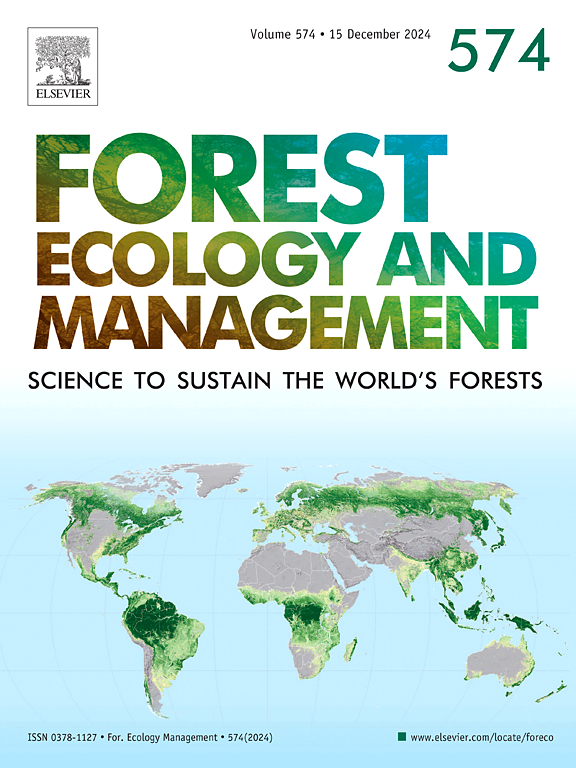Modeling tree radial growth with competition and crown characteristics from an aerial perspective
IF 3.7
2区 农林科学
Q1 FORESTRY
引用次数: 0
Abstract
Tree growth is a central aspect of stand dynamics; however, traditional methods for measuring tree growth have limitations, including destructive sampling and the need to remeasure plots periodically. Unmanned aerial vehicle laser scanning (ULS) provides new opportunities for precise, detailed, nondestructive, stand-scale reconstruction of tree canopies via three-dimensional structural methods. However, the aerial canopy information generated by ULS has not yet been effectively applied in exploring tree growth. This study was designed to analyze and quantify the influences of crown structural characteristics and competition among individual trees on increments by combining field-measured growth data with single-temporal ULS data. An automated point cloud processing method was employed to characterize 7112 trees on 71 sample plots of larch in three dimensions to extract information in the form of distinct crown structural factors and competition indices. The results revealed that crown structural characteristics and competition indices determined via ULS were closely linked to tree growth. Specifically, among the crown variables, the crown exposed surface area was the most strongly correlated with tree growth (r=0.34), and the distance-independent competition index showed a stronger negative correlation (r=-0.61) with tree growth than the other competition indices. The metrics extracted from ULS can explain 53.9 % of the variation in growth. This study evaluated the potential for using the latest ULS data as input, in conjunction with an automated point cloud processing algorithm, to forecast future tree growth, which could inform the development of more effective strategies for forest management.
从空中视角模拟树木径向生长与竞争和树冠特征
树木生长是林分动态的一个核心方面;然而,测量树木生长的传统方法有其局限性,包括破坏性采样和需要定期重新测量地块。无人机激光扫描(ULS)为通过三维结构方法精确、详细、无损地重建林分规模的树冠提供了新的机遇。然而,ULS 生成的空中树冠信息尚未有效应用于探索树木生长。本研究旨在通过将实地测量的生长数据与单时 ULS 数据相结合,分析并量化树冠结构特征和单棵树木之间的竞争对 DBH 增量的影响。采用自动点云处理方法对落叶松 71 个样地上的 7112 棵树进行了三维表征,以提取不同树冠结构因子和竞争指数形式的信息。结果表明,通过 ULS 确定的树冠结构特征和竞争指数与树木的 DBH 生长密切相关。具体而言,在树冠变量中,树冠暴露表面积与树木DBH生长的相关性最强(r=0.34),与其他竞争指数相比,与距离无关的竞争指数与树木生长的负相关性更强(r=-0.61)。从 ULS 中提取的指标可以解释 53.9 % 的 DBH 生长变化。这项研究评估了使用最新的 ULS 数据作为输入,结合自动点云处理算法来预测未来树木 DBH 生长的潜力,从而为制定更有效的森林管理策略提供依据。
本文章由计算机程序翻译,如有差异,请以英文原文为准。
求助全文
约1分钟内获得全文
求助全文
来源期刊

Forest Ecology and Management
农林科学-林学
CiteScore
7.50
自引率
10.80%
发文量
665
审稿时长
39 days
期刊介绍:
Forest Ecology and Management publishes scientific articles linking forest ecology with forest management, focusing on the application of biological, ecological and social knowledge to the management and conservation of plantations and natural forests. The scope of the journal includes all forest ecosystems of the world.
A peer-review process ensures the quality and international interest of the manuscripts accepted for publication. The journal encourages communication between scientists in disparate fields who share a common interest in ecology and forest management, bridging the gap between research workers and forest managers.
We encourage submission of papers that will have the strongest interest and value to the Journal''s international readership. Some key features of papers with strong interest include:
1. Clear connections between the ecology and management of forests;
2. Novel ideas or approaches to important challenges in forest ecology and management;
3. Studies that address a population of interest beyond the scale of single research sites, Three key points in the design of forest experiments, Forest Ecology and Management 255 (2008) 2022-2023);
4. Review Articles on timely, important topics. Authors are welcome to contact one of the editors to discuss the suitability of a potential review manuscript.
The Journal encourages proposals for special issues examining important areas of forest ecology and management. Potential guest editors should contact any of the Editors to begin discussions about topics, potential papers, and other details.
 求助内容:
求助内容: 应助结果提醒方式:
应助结果提醒方式:


